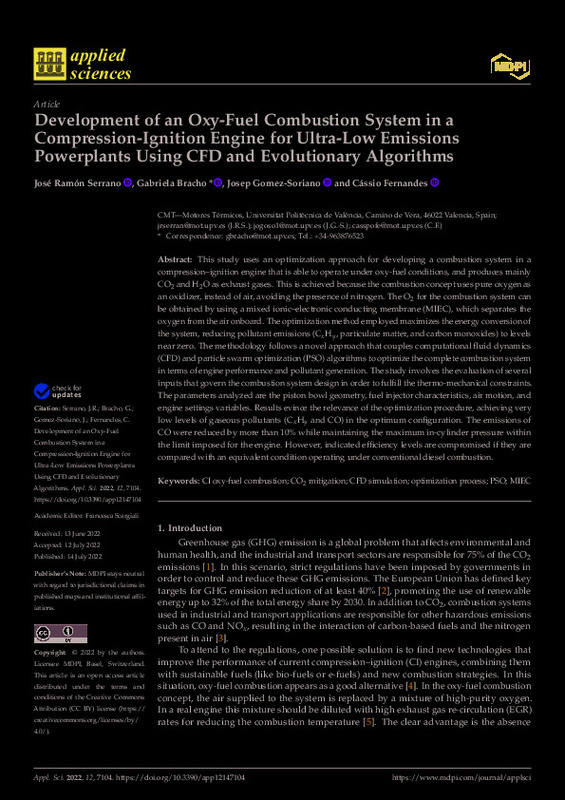JavaScript is disabled for your browser. Some features of this site may not work without it.
Buscar en RiuNet
Listar
Mi cuenta
Estadísticas
Ayuda RiuNet
Admin. UPV
Development of an Oxy-Fuel Combustion System in a Compression-Ignition Engine for Ultra-Low Emissions Powerplants Using CFD and Evolutionary Algorithms
Mostrar el registro sencillo del ítem
Ficheros en el ítem
| dc.contributor.author | Serrano, J.R.
|
es_ES |
| dc.contributor.author | Bracho Leon, Gabriela
|
es_ES |
| dc.contributor.author | Gómez-Soriano, Josep
|
es_ES |
| dc.contributor.author | Spohr-Fernandes, Cássio
|
es_ES |
| dc.date.accessioned | 2023-05-29T18:03:06Z | |
| dc.date.available | 2023-05-29T18:03:06Z | |
| dc.date.issued | 2022-07 | es_ES |
| dc.identifier.uri | http://hdl.handle.net/10251/193728 | |
| dc.description.abstract | [EN] This study uses an optimization approach for developing a combustion system in a compression-ignition engine that is able to operate under oxy-fuel conditions, and produces mainly CO2 and H2O as exhaust gases. This is achieved because the combustion concept uses pure oxygen as an oxidizer, instead of air, avoiding the presence of nitrogen. The O-2 for the combustion system can be obtained by using a mixed ionic-electronic conducting membrane (MIEC), which separates the oxygen from the air onboard. The optimization method employed maximizes the energy conversion of the system, reducing pollutant emissions (CxHy, particulate matter, and carbon monoxides) to levels near zero. The methodology follows a novel approach that couples computational fluid dynamics (CFD) and particle swarm optimization (PSO) algorithms to optimize the complete combustion system in terms of engine performance and pollutant generation. The study involves the evaluation of several inputs that govern the combustion system design in order to fulfill the thermo-mechanical constraints. The parameters analyzed are the piston bowl geometry, fuel injector characteristics, air motion, and engine settings variables. Results evince the relevance of the optimization procedure, achieving very low levels of gaseous pollutants (CxHy and CO) in the optimum configuration. The emissions of CO were reduced by more than 10% while maintaining the maximum in-cylinder pressure within the limit imposed for the engine. However, indicated efficiency levels are compromised if they are compared with an equivalent condition operating under conventional diesel combustion. | es_ES |
| dc.description.sponsorship | This research work has been supported by Grant PDC2021-120821-I00 funded by MCIN/AEI/10.13039/501100011033 and by EuropeanUnion NextGenerationEU/PRTR. This research was partially supported by Agencia Valenciana de la Innovacio (AVI) through the project "Demostrador de un motor de oxicombustion con captura de CO2" (INNVA1/2021/38). | es_ES |
| dc.language | Inglés | es_ES |
| dc.publisher | MDPI AG | es_ES |
| dc.relation.ispartof | Applied Sciences | es_ES |
| dc.rights | Reconocimiento (by) | es_ES |
| dc.subject | CI oxy-fuel combustion | es_ES |
| dc.subject | CO2 mitigation | es_ES |
| dc.subject | CFD simulation | es_ES |
| dc.subject | Optimization process | es_ES |
| dc.subject | PSO | es_ES |
| dc.subject | MIEC | es_ES |
| dc.subject.classification | MAQUINAS Y MOTORES TERMICOS | es_ES |
| dc.subject.classification | INGENIERIA AEROESPACIAL | es_ES |
| dc.title | Development of an Oxy-Fuel Combustion System in a Compression-Ignition Engine for Ultra-Low Emissions Powerplants Using CFD and Evolutionary Algorithms | es_ES |
| dc.type | Artículo | es_ES |
| dc.identifier.doi | 10.3390/app12147104 | es_ES |
| dc.relation.projectID | info:eu-repo/grantAgreement/AGENCIA ESTATAL DE INVESTIGACION//PDC2021-120821-I00//RECUPERACION DE ENERGIA DE GASES DE ESCAPE PARA LA OPTIMIZACION DE MOTORES DE OXI-COMBUSTION DE E-COMBUSTIBLES CON CAPTURA DE CO2 DE ALTA PUREZA/ | es_ES |
| dc.relation.projectID | info:eu-repo/grantAgreement/AGENCIA VALENCIANA DE LA INNOVACION//INNVA1%2F2021%2F38//DEMOSTRADOR DE UN MOTOR DE OXICOMBUSTION CON CAPTURA DE CO2 (DMOCCO2)/ | es_ES |
| dc.rights.accessRights | Abierto | es_ES |
| dc.contributor.affiliation | Universitat Politècnica de València. Escuela Técnica Superior de Ingenieros Industriales - Escola Tècnica Superior d'Enginyers Industrials | es_ES |
| dc.contributor.affiliation | Universitat Politècnica de València. Escuela Técnica Superior de Ingeniería del Diseño - Escola Tècnica Superior d'Enginyeria del Disseny | es_ES |
| dc.description.bibliographicCitation | Serrano, J.; Bracho Leon, G.; Gómez-Soriano, J.; Spohr-Fernandes, C. (2022). Development of an Oxy-Fuel Combustion System in a Compression-Ignition Engine for Ultra-Low Emissions Powerplants Using CFD and Evolutionary Algorithms. Applied Sciences. 12(14):1-27. https://doi.org/10.3390/app12147104 | es_ES |
| dc.description.accrualMethod | S | es_ES |
| dc.relation.publisherversion | https://doi.org/10.3390/app12147104 | es_ES |
| dc.description.upvformatpinicio | 1 | es_ES |
| dc.description.upvformatpfin | 27 | es_ES |
| dc.type.version | info:eu-repo/semantics/publishedVersion | es_ES |
| dc.description.volume | 12 | es_ES |
| dc.description.issue | 14 | es_ES |
| dc.identifier.eissn | 2076-3417 | es_ES |
| dc.relation.pasarela | S\469057 | es_ES |
| dc.contributor.funder | European Commission | es_ES |
| dc.contributor.funder | AGENCIA ESTATAL DE INVESTIGACION | es_ES |
| dc.contributor.funder | AGENCIA VALENCIANA DE LA INNOVACION | es_ES |
| dc.subject.ods | 07.- Asegurar el acceso a energías asequibles, fiables, sostenibles y modernas para todos | es_ES |
| dc.subject.ods | 09.- Desarrollar infraestructuras resilientes, promover la industrialización inclusiva y sostenible, y fomentar la innovación | es_ES |
| dc.subject.ods | 13.- Tomar medidas urgentes para combatir el cambio climático y sus efectos | es_ES |








